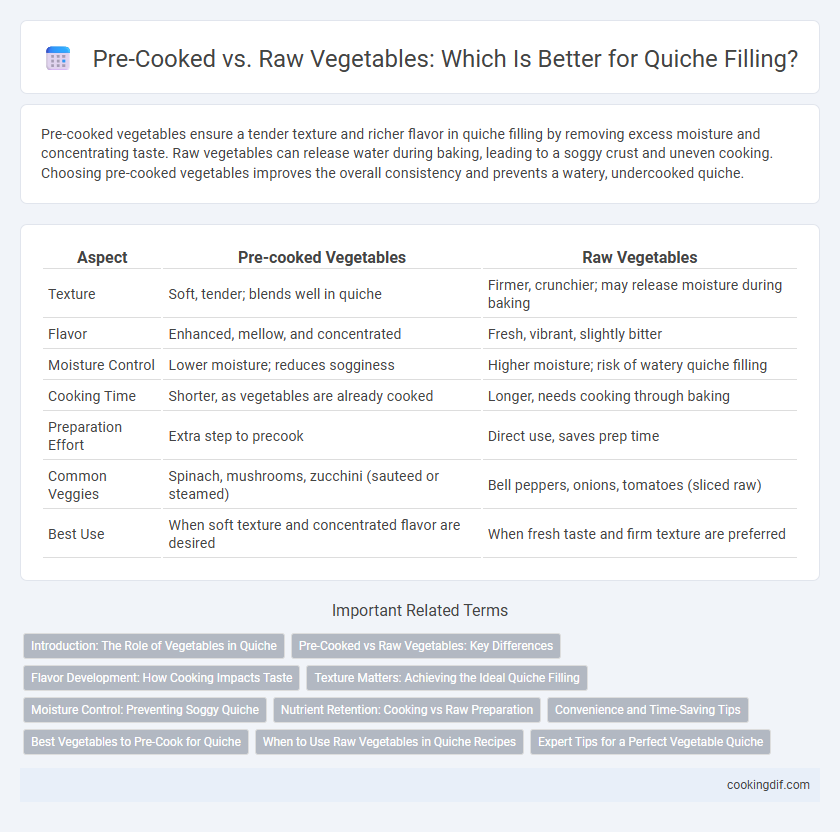Pre-cooked vegetables ensure a tender texture and richer flavor in quiche filling by removing excess moisture and concentrating taste. Raw vegetables can release water during baking, leading to a soggy crust and uneven cooking. Choosing pre-cooked vegetables improves the overall consistency and prevents a watery, undercooked quiche.
Table of Comparison
| Aspect | Pre-cooked Vegetables | Raw Vegetables |
|---|---|---|
| Texture | Soft, tender; blends well in quiche | Firmer, crunchier; may release moisture during baking |
| Flavor | Enhanced, mellow, and concentrated | Fresh, vibrant, slightly bitter |
| Moisture Control | Lower moisture; reduces sogginess | Higher moisture; risk of watery quiche filling |
| Cooking Time | Shorter, as vegetables are already cooked | Longer, needs cooking through baking |
| Preparation Effort | Extra step to precook | Direct use, saves prep time |
| Common Veggies | Spinach, mushrooms, zucchini (sauteed or steamed) | Bell peppers, onions, tomatoes (sliced raw) |
| Best Use | When soft texture and concentrated flavor are desired | When fresh taste and firm texture are preferred |
Introduction: The Role of Vegetables in Quiche
Pre-cooked vegetables for quiche filling release less moisture during baking, ensuring a firmer, less soggy crust while intensifying flavors through caramelization. Raw vegetables retain more water, which can dilute the custard mixture and soften the pie's texture, demanding careful chopping or pre-draining. Selecting the appropriate vegetable preparation method impacts the balance between moisture control and taste concentration in the final quiche.
Pre-Cooked vs Raw Vegetables: Key Differences
Pre-cooked vegetables in quiche filling offer a softer texture and concentrated flavors due to moisture reduction during cooking, preventing a soggy crust. Raw vegetables retain a firmer bite and fresher taste but release moisture while baking, which can affect quiche consistency. Choosing pre-cooked vegetables like sauteed spinach or caramelized onions enhances flavor depth and ensures optimal filling texture.
Flavor Development: How Cooking Impacts Taste
Pre-cooked vegetables for quiche filling develop deeper, caramelized flavors through the Maillard reaction and moisture reduction, enhancing the overall taste profile. Raw vegetables tend to release more water during baking, which can dilute flavors and create a soggy texture. Cooking vegetables beforehand intensifies sweetness and umami, contributing to a richer, more balanced quiche flavor.
Texture Matters: Achieving the Ideal Quiche Filling
Pre-cooked vegetables for quiche filling release moisture and soften during baking, preventing sogginess and ensuring a firm, well-set texture. Raw vegetables retain a firmer bite but may cause excess water to seep into the custard, leading to a less stable filling. Balancing vegetable preparation enhances texture, avoiding watery quiches while preserving desired vegetable crispness.
Moisture Control: Preventing Soggy Quiche
Pre-cooked vegetables release less moisture during baking, significantly reducing the risk of a soggy quiche crust compared to raw vegetables. Techniques such as sauteing or roasting vegetables before adding them to the filling help evaporate excess water content. Proper moisture control ensures a firm, flavorful quiche with a crisp, golden crust.
Nutrient Retention: Cooking vs Raw Preparation
Pre-cooked vegetables in quiche fillings often have reduced nutrient levels due to heat-sensitive vitamins like vitamin C and folate breaking down during cooking, while raw vegetables retain higher amounts of these nutrients. However, cooking vegetables can increase the bioavailability of certain antioxidants, such as beta-carotene in carrots and lycopene in tomatoes, enhancing nutrient absorption. Balancing raw and cooked vegetables in quiche fillings optimizes both nutrient retention and flavor profile, providing a more nutritious dish overall.
Convenience and Time-Saving Tips
Pre-cooked vegetables for quiche filling significantly reduce preparation time by softening ingredients beforehand, making them more convenient for quick meal assembly. Using raw vegetables requires longer baking to ensure they cook through, which can extend overall cooking time and risk a soggy crust. For efficient meal prep, steaming or roasting vegetables in advance allows for a tender texture and consistent flavor balance in the quiche.
Best Vegetables to Pre-Cook for Quiche
Pre-cooking vegetables like spinach, mushrooms, bell peppers, and onions enhances quiche filling by reducing moisture and intensifying flavors, preventing soggy crusts. Leafy greens such as spinach benefit from sauteing to remove excess water, while mushrooms release their moisture and develop a richer taste when cooked beforehand. Raw vegetables like zucchini and tomatoes should be pre-cooked or salted and drained to avoid excess liquid seeping into the quiche custard.
When to Use Raw Vegetables in Quiche Recipes
Using raw vegetables in quiche fillings works best for ingredients that release minimal moisture during cooking, such as spinach, bell peppers, or green onions, preserving their crisp texture and vibrant flavor. Raw vegetables should be sliced thinly to ensure even cooking and avoid sogginess within the custard. Incorporating raw vegetables is ideal when aiming for a fresh, slightly crunchy bite and when the quiche baking time allows these ingredients to cook thoroughly without pre-softening.
Expert Tips for a Perfect Vegetable Quiche
Pre-cooked vegetables release excess moisture, preventing a soggy quiche crust and ensuring a firm, well-set filling. Raw vegetables, if used, must be sauteed or drained thoroughly to avoid waterlogged texture and uneven cooking. Expert tip: blanching or roasting vegetables intensifies flavor while maintaining structure, perfecting your quiche's balance of taste and texture.
Pre-cooked vegetables vs raw vegetables for quiche filling Infographic

 cookingdif.com
cookingdif.com